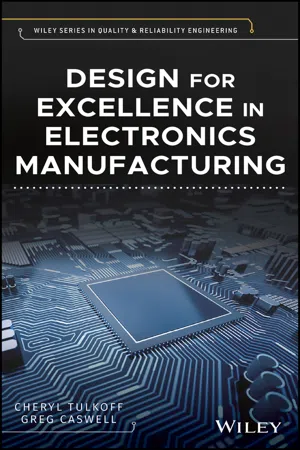
- English
- ePUB (mobile friendly)
- Available on iOS & Android
Design for Excellence in Electronics Manufacturing
About this book
An authoritative guide to optimizing design for manufacturability and reliability from a team of experts
Design for Excellence in Electronics Manufacturing is a comprehensive, state-of-the-art book that covers design and reliability of electronics. The authors—noted experts on the topic—explain how using the DfX concepts of design for reliability, design for manufacturability, design for environment, design for testability, and more, reduce research and development costs and decrease time to market and allow companies to confidently issue warranty coverage.
By employing the concepts outlined in Design for Excellence in Electronics Manufacturing, engineers and managers can increase customer satisfaction, market share, and long-term profits. In addition, the authors describe the best practices regarding product design and show how the practices can be adapted for different manufacturing processes, suppliers, use environments, and reliability expectations. This important book:
- Contains a comprehensive review of the design and reliability of electronics
- Covers a range of topics: establishing a reliability program, design for the use environment, design for manufacturability, and more
- Includes technical information on electronic packaging, discrete components, and assembly processes
- Shows how aspects of electronics can fail under different environmental stresses
Written for reliability engineers, electronics engineers, design engineers, component engineers, and others, Design for Excellence in Electronics Manufacturing is a comprehensive book that reveals how to get product design right the first time.
Frequently asked questions
- Essential is ideal for learners and professionals who enjoy exploring a wide range of subjects. Access the Essential Library with 800,000+ trusted titles and best-sellers across business, personal growth, and the humanities. Includes unlimited reading time and Standard Read Aloud voice.
- Complete: Perfect for advanced learners and researchers needing full, unrestricted access. Unlock 1.4M+ books across hundreds of subjects, including academic and specialized titles. The Complete Plan also includes advanced features like Premium Read Aloud and Research Assistant.
Please note we cannot support devices running on iOS 13 and Android 7 or earlier. Learn more about using the app.
Information
1
Introduction to Design for Excellence
1.1 Design for Excellence (DfX) in Electronics Manufacturing
1.2 Chapter 2: Establishing a Reliability Program
- Understand the basic elements of a successful reliability program
- Understand the principles associated with reliability analysis and management of the factors that affect product reliability
- Understand the probability density function (PDF) and the cumulative distribution function (CDF) used in reliability
- Understand the reliability prediction models available
1.3 Chapter 3: Design for Reliability (DfR)
1.4 Chapter 4: Design for the Use Environment: Reliability Testing and Test Plan Development
- Understand the basic elements of a successful reliability testing program
- Understand how reliability testing can be used for the process, part and assembly qualification
- Understand failure patterns based on the ensemble of environmental stressors chosen
- Have a basic understanding of the concepts of accelerated aging rates and acceleration factors
- Understand the difference between a stress screen and an accelerated life test
- Understand the basics of stress‐screening equipment
- Have a basic understanding of frequency analysis and power spectral density for vibration and mechanical shock testing
- Have a basic understanding of setting stress levels based on the step‐stress algorithm to establish the product operational and destruct limits
- Know how to use the testing process to drive improved reliability in the products manufactured at every site
- Know how to drive robust product design with the testing process and push product performance to the fundamental limits of the material and device technology
1.5 Chapter 5: Design for Manufacturability (DfM)
1.6 Chapter 6: Design for Sustainability
- Obsolescence management
- Long‐term storage issues
- Counterfeit prevention and detection strategies
- Baseline life‐cycle cost (estimated total ownership cost)
- Use environment verification
- Corrosion protection and mitigation
- Supplier auditing and vendor maturity and stability
1.7 Chapter 7: Root Cause Problem‐Solving, Failure Analysis, and Continual Improvement Techniques
Table of contents
- Cover
- Table of Contents
- Series Title
- Title Page
- Copyright
- Dedication
- Contributors
- List of Figures
- List of Tables
- Series Editor's Foreword by Dr. Andre Kleyner
- Foreword
- Preface
- Acknowledgments
- Acronyms
- 1 Introduction to Design for Excellence
- 2 Establishing a Reliability Program
- 3 Design for Reliability
- 4 Design for the Use Environment: Reliability Testing and Test Plan Development
- 5 Design for Manufacturability
- 6 Design for Sustainability
- 7 Root Cause Problem‐Solving, Failure Analysis, and Continual Improvement Techniques
- 8 Conclusion to Design for Excellence: Bringing It All Together
- Index
- End User License Agreement